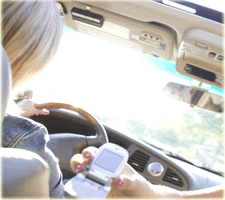Monthly Archives: October 2010
New Florida Driver’s License/ID Card Requirements for 2011
October 18, 2010
Florida enacted a new law on January 1, 2010, in order to comply with the federal Real ID Act, passed by Congress in 2005. Florida’s new law requires more positive proof of identification for anyone trying to get a license or a Florida ID card.
Lack of awareness of this law has resulted in a lot of customers at the DDL office who were turned away for lack of proper proof of identification. If you are planning to visit the DDL anytime soon, you will need to carry the required items of documentation with you if you need to:
- Apply for a new license or ID card
- Renew a license or ID card
- Change your name
- Change your address
- Replace a lost or stolen license
(If there are no changes, simple renewals can still be done online at: http://www.flhsmv.gov/html/online.html )
Primary Identification (proof of citizenship or legal presence). You need to provide ONE original or certified copy of any of the following:
- Certified United States birth certificate
- Valid United States Passport or Passport Card
- Consular Report of Birth Abroad
- Certificate of Naturalization, Form N-550 or Form N-570
- Certificate of Citizenship, Form N-560 or Form N-561
If a birth certificate is your chosen form of primary identification, then it must come from a government agency; hospital birth certificates are not accepted.
When necessary, marriage certificates, court orders, or divorce decrees must be provided to tie the name on the primary identification to the name the customer would like to place on the driver license or identification card.
Those born in Puerto Rico must present an new, updated birth certificate after September 30, 2010.
2. Proof of Social Security Number. Provide ONE original or certified copy of any of the following that proves your social security number tied to your full name.
- Social Security Card (must be an original and must be under name being applied for)
- W-2 Form
- Pay check/stub
- SSA-1099
- Any 1099 (not handwritten)
If an applicant currently does not have a social security number, one must bring a letter from the Social Security Administration indicating that the applicant was not issued one. In addition, secondary identification is required, which could be any of the following:
- A driver license from the District of Columbia, U.S. Territories or one from the 50 states
- School record starting date of birth, with the registrar’s signature
- Transcript of the birth record
- Baptism certificate, with the date of birth and place of baptism
- Family Bible record
- An insurance policy on the applicant’s name, which has been in place for at least 2 years
- United States military or military dependent identification card
- An identification card from the District of Columbia, U.S. Territories or one from the 50 states
- Florida license record or identification card record
- Selective Service Registration
- Florida Vehicle Registration Certificate (HSMV 83399, owner’s copy) or out-of-state registration certificate with name and date of birth
- Receipt copy of last Florida driver license issuance
- Immigration form I-571
- Federal form DD-214
- Marriage certificates
- Court order, which includes applicant’s legal name
- A Florida voter registration card, which was issued at least 3 months previously
- Parent consent form of minor, signed by the parent or legal guardian
- Government issued out-of-country passport, driver license or identification card
- Concealed weapons permit
Making the social security number a requirement reinforces the idea that social security is indeed, for social security.
3. Two Proofs of Residential Address. Bring TWO different documents that confirm the applicant’s residential address. It could by any TWO of the following:
- Deed, mortgage, rental/lease statement
- Florida Voter Registration Card
- Florida Vehicle Registration or Title
- Florida Boat Registration or Title
- TWO Proofs of residential address from a parent/legal guardian, along with a statement from a parent/legal guardian with whom the applicant resides with
- A utility hook up or work order dated within 60 days of application
- Automobile Payment Booklet
- Selective Service Card
- Medical/Health card with address
- Current homeowner’s insurance policy/bill
- Current automobile insurance policy/bill
- Transcript forms from current school year
- Unexpired professional license issued by government agency in the U.S.
- W-2 form or 1099 form
- Form DS2019, Certificate of Eligibility for Exchange Visitor (J-1) status
- A letter from a homeless shelter/transitional service provider/half-way house verifying that they receive mail for applicant
- Certificate of Address Form
- Utility bills
- Mail from financial institutions
- Mail from federal State, County or City government agencies
If an applicant’s current driver’s license has a P.O. Box under address, records must be updated that verify an applicant’s physical address. The address will be placed when the applicant next renews his/her license.
For more information, visit: http://www.gathergoget.com/

What is being done to Stop Distracted Driving?
October 12, 2010
Each day there is more research conducted, articles written and information available about the dangers of distracted driving. This increase in awareness is highlighting the growing problem all drivers face on the roadways. Distracted driving has been estimated to cause over 11,500 deaths in the last two years. But what has been done to eliminate the problem? What initiatives are organizations and individuals doing to combat distracted driving?
Forming Organizations
When you Google “distracted driving groups” you will find varied results of individuals banding together to increase awareness on distracted driving, on a local or country-wide basis. The organizations can be as simple as asking people to pledge against distracted driving, like Oprah’s No Phone Zone, or wearing thumb socks to show a driver’s support for not texting while driving. These groups establish their presence online, in various social networking services, making it easier to distribute the message.
Enacting Laws
With the nationwide awareness on the shocking statistics of texting while driving, the Federal, state and local governments and municipalities have proposed and enacted laws to prohibit cell phone usage while on the road. So far, more than 30 states have a law that places a ban on texting while behind the wheel, urging drivers to think twice before they pull out their phones. The type of penalties and amount of fines range from location to location. Currently, the options are being weighed on how to effectively further enforce texting ban laws.
Phone/Text-blocker apps
How to stop phone use while on the road? Simple. Install a phone/text-blocker application. These applications interface the cell phone to the vehicle’s Global Positioning System (GPS) to see if the car is in motion. If so, the application disables the cell phone’s call and/or texting features. With crash-risk increasing four times/talking on the phone and 23 times/texting, it can help discipline the driver into not relying on their phones so much while on the road, until they break the habit.
Mock Crashes
Several local/teen driving advocacy groups have set up mock crashes to remind teen drivers (the group most likely to engage in texting while driving) what could potentially happen if they text and drive at the same time. In most places, the mock crashes are set up at the entrance of the school depicting the wrecked cars, actors as teen drivers, playing dead with phone in-hand. It is a shocking, yet accurate statement that reminds teen drivers of the potential consequences.
Trial Runs
There are also trial course runs, usually hosted by a state’s Division of Motor Vehicles along with several advocates against distracted driving. They allow drivers to experience firsthand what could happen should they attempt to text while driving. Set in an enclosed space, with only traffic cones as obstacles and are operated at low speeds. These courses are designed to show drivers that they are unable to handle both tasks, by challenging them to maneuver their vehicle safety and skillfully while driving distracted.
Advertising and Videos
Various organizations release ads that are either funny or serious in order to make their point. Some organizations do their advertisements a step above by involving the people themselves. They create contests asking drivers if they have what it takes to get the message across, in a video format. The advantages of these types of contests include maintaining a limited budget, creating enthusiasm, spurring creativity and raising safety awareness in teen drivers.
People are motivated to change their behavior in different ways. One or all of these approaches can be incorporated to stop distracted driving. Take a proactive approach to know the dangers and help stop distracted driving.

Five Tips After Teens Get Their Driver’s License
October 8, 2010
Once a teen gets their driver’s license, they will want to apply their new skill all the time. Some teens even volunteer to be the family driver and errand runner! (Depending on what age, and what kind of license they have.) But just because they have their license, the process of learning to drive isn’t over. Driver’s Education is continuing education, and there are still several things to tackle.
Here are a few tips for teens after they get their license:
- Encourage your parents to sign a parent-teen driving contract. If you don’t have one set up already, then show the initiative. Be the teen who demonstrates to their parents or guardian that they are willing to agree to some terms if they are going to help shoulder the responsibility of driving. It will save you both from any misunderstandings, over-reactions, and hard feelings, on the interpretations, expectations and consequences of your driving privilege.
- Practice, practice, practice. Though the teen may have his/her license, it’s easy for them and their parents to get complacent. While they may be skilled on how to drive, mastering and fine-tuning their skills only comes with experience. There’s still always much to master when it comes to driving, and asking a parent for help more not only increases that teen’s driving ability and safety, but also makes him/her bond closer with their parent. The evolution from learning to drive to becoming a safe and defensive driver is a long term progression. Parents need to stay engaged through out the process.
- Clear the dashboard. Like life, teens should remove unnecessary distractions when it comes to driving. Have disc-changers ready and music set before starting the vehicle. Keep cell phones in the glove compartment away from the driver’s reach. Also important, don’t be a chauffeur for friends. Having other teens in the car is a major form of distraction while driving, and research shows it increases the risk of a crash per passenger, exponentially.
- Clear your head someplace else. Driving isn’t a stress-reliever. When a teen has a problem, he/she shouldn’t use driving to clear his head. When a preoccupied mind does something that requires full attention, like driving, there is more likely to be mistakes. Having a talk with a friend, when you are not doing something else (like driving) is one of the best ways to cool one’s head. Driving when you are upset, angry or even extremely happy can be dangerous.
- Check the labels. Before taking any form of medication, even over-the-counter drugs, remember to check the labels. Some drugs have side-effects when taken, which may include dizziness or drowsiness. Either of which is never good for driving. Some medicines may give off false driving-under-the-influence signals. Make sure you are rested and in good health. Your physical health and well being can affect awareness, judgment and reaction time each important for safe driving.
Having your driver’s license does not mean you are good to go. In order to be a safe driver, there is still continuing education needed and defensive driving techniques to learn. Take advantage of this time to continue to be engaged in driver education as you gradually increase the opportunities and responsibilities driving brings.

Five Tips Before Teens Get Their Drivers License
October 6, 2010
A common rite of passage for teenagers is getting their driver’s license. Before teens get their license, they have to prepare themselves thoroughly. Here are a five tips for teens as they work towards their driver’s license:
1. Study the handbook. It’s surprising what kind of motivation teens have when it comes to studying for their driving test. The written part of the driving exam is pretty much like other tests for classes in school: you have to study to pass. You don’t study, you fail. You never know which part of the driving manual will appear in the exam, so it important to be well versed on the material to increase the chances of passing. If you decide you want to practice more, you can sign up for a drivers license practice test online course. You’ll get to see over 1,500 questions and answers similar to those found on the written driver’s test, along with detailed explanations.
2. Find out about the local GDL laws. Different states have different Graduated Drivers License (GDL) laws, and it’s worth noting that many states have varied age and time of day restrictions, passenger and mobile device limitations, and educational requirements before teens can get a full license. Also, the penalties and ordinances change depending on where you drive. Be familiar with the laws and ordinances for teen drivers for where you live and the places you plan to drive with your teen.
3. Make a covenant with parents. Straight talk and clear guidelines between teen drivers and their parents or guardians will assist teen driver safety. Setting boundaries that teens and parents can agree on will give teens an idea of the responsibility they will be undertaking. A Teen Driving Contract will help to guide and establish the expectations and consequences of driving privileges and behavior.
4. Practice makes perfect. A teen should always insist on getting more practice with their driving. On the other hand, parents and guardians over 21 years-old, should be more than willing to accompany them and teach them how to drive properly, especially in different types of weather and road conditions and environments, including nighttime, rain, and expressway driving. Several states require 50 hours of behind the wheel driving practice as a minimum, before full licensure. To help record this time, use a driving log. A printable version can be found at
5. No, focus makes perfect. Learning to maneuver the vehicle with ease and control is a milestone. But if a teen cannot stay focused, they are not ready to drive alone. This tip works in conjunction with the tips above. Giving each task the required amount of attention will make teen drivers reach their goal of becoming better drivers. Removing distractions to driving and keeping them focused on their interaction with the changing driving environment will not only make getting their license easier, it will help them be a safer driver.
Use these tips to help to set your teen up for success as they embark on preparing for their license. It is an exciting time of new endeavors and more independence. Have fun and be safe!
